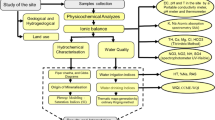Abstract
Majority of the people of Pakistan get drinking water from groundwater source. Nearly 40 % of the total ailments reported in Pakistan are the result of dirty drinking water. Every summer, thousands of patients suffer from acute gastroenteritis in the Rawal Town. Therefore, a study was designed to generate a water quality index map of the Rawal Town and identify the relationship between bacteriological water quality and socio-economic indicators with gastroenteritis in the study area. Water quality and gastroenteritis patient data were collected by surveying the 262 tubewells and the major hospitals in the Rawal Town. The collected spatial data was analyzed by using ArcGIS spatial analyst (Moran’s I spatial autocorrelation) and geostatistical analysis tools (inverse distance weighted, radial basis function, kriging, and cokriging). The water quality index (WQI) for the study area was computed using pH, turbidity, total dissolved solids, calcium, hardness, alkalinity, and chloride values of the 262 tubewells. The results of Moran’s I spatial autocorrelation showed that the groundwater physicochemical parameters were clustered. Among IDW, radial basis function, and kriging and cokriging interpolation techniques, cokriging showed the lowest root mean square error. Cokriging was used to make the spatial distribution maps of water quality parameters. The WQI results showed that more than half of the tubewells in the Rawal Town were providing “poor” to “unfit” drinking water. The Pearson’s coefficient of correlation for gastroenteritis with fecal coliform was found significant (P < 0.05) in Water and Sanitation Agency (WASA) zone 2, and with shortage of toilets, it was significant (P < 0.05) in WASA zones 1 and 3. However, it was significantly (P < 0.01) inversely related with literacy rate in WASA zones 1, 2, and 3.








Similar content being viewed by others
References
Asadi, S. S., Vuppala, P., & Reddy, M. A. (2007). Remote sensing and GIS techniques for evaluation of groundwater quality in municipal corporation of Hyderabad (Zone-V), India. International Journal of Environmental Research and Public Health, 4(1), 45–52.
Chatterjee, R., Tarafder, G., & Paul, S. (2010). Groundwater quality assessment of Dhanbad district, Jharkhand, India. Bulletin of Engineering Geology and the Environment, 69, 137–141.
ESRI. (2001). Using ArcGIS Geostatistical Analyst. Redlands, U.S.A.: GIS by ESRI.
ESRI. (2005). Basics of the Geodatabase Data Model.
Germs, W., Coetzee, M. S., Rensburg, L. V., & Maboeta, M. S. (2004). A preliminary assessment of the chemical and microbial water quality of the Chunies River (pp. 267–272). Limpopo: Water SA.
Hashmi, I., Farooq, S., & Qaiser, S. (2009). Incidence of fecal contamination within a public drinking water supply in Ratta Amral, Rawalpindi. Desalination and Water Treatment, 1–8
Hashmi, I., Qaiser, S., Asma, S., Khan, M, T, A., & Abbas, S. (2011, April). Assessing microbiological safety of drinking water: a case study of Islamabad, Pakistan. World Water Day, pp. 29–36
Ketata-Rokbani, M., Gueddari, M., & Bouhlila, R. (2011). Use of Geographical Information System and Water Quality Index to assess groundwater quality in El Khairat Deep Aquifer (Enfidha, Tunisian Sahel). Iranica Journal of Energy and Environment, 2(2), 133–144.
Latha,P, S., & Rao, K, N. (2010). Assessment and spatial distribution of quality of groundwater in ZoneII and III, Greater Visakhapatnam, India using Water Quality Index (WQI) and GIS. International Journal Of Environmental Sciences, 198–212
Ministry of Health, New Zealand. (2005). Microbiological quality. In The Guidelines for Drinking-water Quality Management for New Zealand (pp. 1–24). http://www.health.govt.nz/publication/guidelines-drinking-water-quality-management-new-zealand.
Nas, B., & Berktay, A. (2010). Groundwater quality mapping in urban groundwater using GIS. Environmental Monitoring and Assessment, 160, 215–227.
Pakistan Environmental Protection Agency, Government of Pakistan. (2008). National Standards for Drinking Water Quality (NSDWQ). Islamabad: Ministry of Environment.
PCRWR. (2010). National Water Quality Laboratory. Retrieved March 26, 2012, from Pakistan Council of Research in Water Resources: http://www.pcrwr.gov.pk/labnew.aspx
Qaiser, S., Asma, S., Khan, M, T, A., & Hashmi, I. (2011). Drinking water quality monitoring within a distribution network: F-8 and E-7 Sectors of Islamabad. Pakistan Engineering Congress (pp. 599–616). Lahore: PEC
Rosemann, N. (2005). Drinking water crisis in Pakistan and the issue of bottled water: the case of Nestlé’s ‘Pure Life’. Berne: Swiss Coalition of Development Organisations.
Rustam, S., Saba, N., Qayyum, M., Islam, B., & Qazilbash, A, A. (2006). Enterobacteriaceae:Etiological Agents of Diarrhea. J. Med. Sci, 149–154
The United Nations System in Pakistan. (2003). Water a vital source of living. Islamabad: United Nations Information Centre (UNIC).
USAID. (2005). District Health Profile Rawalpindi.
Water Quality & Health Bureau, Canada. (2006). Guidelines for Canadian drinking water quality: guideline technical document-total coliforms. Ottawa: Health Canada.
World Bank. (2006). Pakistan strategic country environmental assessment
World Health Organization & National Institute of Health. (2005). Guidelines for gastroenteritis including cholera control. Islamabad: Epidemic Investigation Cell, Public Health Laboratories Division National Institute of Health.
WWF. (2007). Pakistan’s waters at risk: water & health related issues in Pakistan & key recommendations. Lahore: WWF – Pakistan.
Acknowledgments
This study was conducted with the student research fund of National University of Sciences and Technology (NUST), Islamabad, Pakistan. The special acknowledgment is paid to Water and Sanitation Authority (WASA), Rawalpindi, for providing the relevant data.
Author information
Authors and Affiliations
Corresponding author
Rights and permissions
About this article
Cite this article
Shahid, S.U., Iqbal, J. & Hasnain, G. Groundwater quality assessment and its correlation with gastroenteritis using GIS: a case study of Rawal Town, Rawalpindi, Pakistan. Environ Monit Assess 186, 7525–7537 (2014). https://doi.org/10.1007/s10661-014-3945-9
Received:
Accepted:
Published:
Issue Date:
DOI: https://doi.org/10.1007/s10661-014-3945-9




